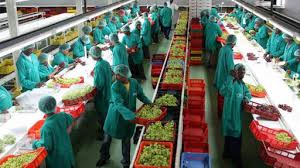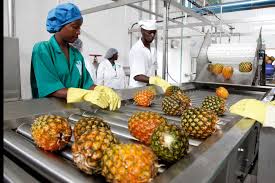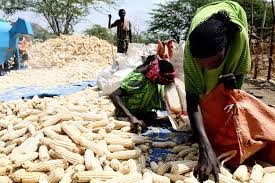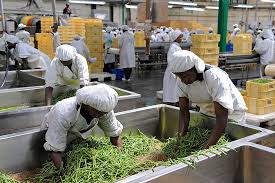Agro-processing refers to the transformation of raw agricultural products into food, beverages, textiles, and other value-added products.
It plays a crucial role in the agricultural value chain, bridging the gap between farmers and consumers. With the global population continuously increasing, the demand for processed food and agricultural products has also risen, making agro-processing an essential component of modern agriculture.
This industry not only enhances food security by ensuring that food products are preserved and readily available but also contributes to economic development, job creation, and rural development.
Agro-processing encompasses a wide range of activities that include the cleaning, sorting, grading, packaging, and preserving of agricultural commodities. The significance of agro-processing in agriculture can be understood through the following key aspects:
1. Value Addition: Agro-processing adds value to raw agricultural products by transforming them into finished goods or semi-processed products. For instance, processing tomatoes into sauces or turning grains into flour not only enhances their market value but also offers consumers a variety of convenient options. This value addition helps farmers earn higher incomes and reduces post-harvest losses.
2. Food Security: By extending the shelf life of agricultural products, agro-processing plays a vital role in food security. Processes like canning, freezing, and drying help preserve food, making it available for longer periods. This is especially important in regions prone to food scarcity, as processed foods can be stored and distributed during lean seasons, ensuring that communities have access to nutritious options year-round.
3. Employment Generation: The agro-processing sector creates numerous job opportunities across various stages of production, from harvesting to processing to distribution. It often employs a significant number of people, especially in rural areas, providing them with livelihoods and contributing to local economies. This job creation can be particularly beneficial for women and youth, who may have limited employment options in traditional agriculture.
4. Economic Development: Agro-processing contributes to overall economic growth by increasing agricultural productivity and fostering rural development. By investing in processing facilities and infrastructure, countries can stimulate local economies, promote entrepreneurship, and encourage the establishment of small and medium enterprises (SMEs). Additionally, agro-processing can enhance trade opportunities by allowing countries to export processed goods rather than raw commodities, increasing their revenue.
5. Innovation and Technology Transfer: The agro-processing industry drives innovation by encouraging the adoption of new technologies and practices. As processors seek to improve efficiency and product quality, they often invest in research and development, leading to technological advancements that can benefit the entire agricultural sector. This can include the development of more efficient machinery, better storage solutions, and improved processing techniques.
6. Sustainability and Waste Reduction: Agro-processing contributes to sustainability by promoting the efficient use of resources and reducing waste. For example, by-products from processing can be utilized for animal feed, compost, or other purposes, minimizing waste and maximizing resource use. Additionally, sustainable processing practices can reduce the environmental impact of agriculture, contributing to more resilient food systems.
Economic Impact of Agriculture

1. Economic Contribution to GDP: Agriculture plays a vital role in the economy of many countries, contributing significantly to the Gross Domestic Product (GDP). In developing nations, agriculture is often the backbone of the economy, providing a substantial share of GDP and influencing overall economic stability. As agriculture grows, it can lead to increased national income, improving the standard of living for many citizens.
2. Contribution to Export Revenues: Agricultural products are often major exports for many countries, generating significant foreign exchange. This revenue is crucial for balancing trade deficits and enabling countries to invest in other sectors, enhancing economic development. For example, countries rich in cash crops like cocoa, coffee, or cotton rely heavily on agricultural exports to sustain their economies.
3. Development of Rural Areas: Agricultural activities stimulate economic growth in rural areas, leading to infrastructure development, improved transportation, and access to markets. Investments in agriculture can transform rural economies, providing the necessary foundation for broader economic development.
Enhancing Food Security
1. Sustainable Food Production: Agriculture is essential for ensuring food security, providing the necessary food supplies for growing populations. Sustainable agricultural practices, such as crop rotation, integrated pest management, and organic farming, enhance food production while preserving environmental health.
2. Local Food Systems: Strengthening local food systems can significantly contribute to food security by reducing dependency on imports. Promoting community-supported agriculture (CSA) and farmers’ markets ensures access to fresh, locally-produced food, benefiting both consumers and producers.
3. Resilience to Shocks: A diversified agricultural sector enhances food security by making communities more resilient to shocks such as climate change, economic downturns, or pandemics. This resilience is built by supporting a variety of crops and livestock, reducing reliance on a single food source.
Value Addition to Raw Materials
1. Processing and Manufacturing: Adding value to raw agricultural materials through processing can significantly enhance economic returns. For instance, converting fruits into jams, juices, or dried products not only increases shelf life but also boosts income for farmers and processors.
2. Branding and Quality Enhancement: Developing branded products with higher quality standards can attract premium prices in both local and international markets. Farmers can benefit from initiatives that emphasize organic or fair-trade certification, tapping into growing consumer demand for ethically produced goods.
3. Innovation in Product Development: Encouraging innovation in agricultural product development can lead to new market opportunities. For example, creating alternative protein sources from plants or developing functional foods can open up new consumer segments.
Read Also: Tangerine and Mandarin Pith: Economic Importance, Uses and By-Products
Employment Generation

1. Job Creation in Agriculture: Agriculture is one of the largest employers in many countries, providing jobs for millions of people. From farming and processing to distribution and retail, agriculture creates diverse job opportunities across the supply chain.
2. Supporting Ancillary Industries: The agricultural sector supports various ancillary industries, including equipment manufacturing, fertilizers, and pesticides. These industries contribute to job creation and economic growth, further strengthening the agricultural economy.
3. Empowerment of Women and Youth: Agriculture provides opportunities for women and youth, often leading to social empowerment. Programs that promote women’s participation in agriculture can improve household incomes and elevate their social status within communities.
Technological Advancements
1. Increased Efficiency and Productivity: Technological advancements in agriculture, such as precision farming, genetically modified organisms (GMOs), and automated machinery, significantly increase efficiency and productivity. These innovations help farmers optimize resource use, reduce waste, and improve crop yields.
2. Access to Information and Data: Technologies such as mobile applications and satellite imagery provide farmers with access to valuable information, including weather forecasts and market prices. This data enables informed decision-making, enhancing agricultural productivity and profitability.
3. Sustainable Practices through Innovation: Technological advancements also support sustainable agricultural practices. Innovations like vertical farming, aquaponics, and hydroponics allow for resource-efficient food production, reducing the environmental footprint of agriculture.
Environmental Sustainability
1. Sustainable Agricultural Practices: Environmental sustainability in agriculture involves adopting practices that minimize ecological impact while maintaining productivity. This includes techniques such as crop rotation, agroforestry, organic farming, and integrated pest management. These practices help preserve soil health, reduce chemical usage, and protect biodiversity, ensuring the long-term viability of agricultural systems.
2. Conservation of Natural Resources: Sustainable agriculture promotes the efficient use of natural resources such as water, soil, and energy. For example, implementing drip irrigation and rainwater harvesting can conserve water resources, while practices like cover cropping improve soil fertility and reduce erosion. This approach not only enhances agricultural productivity but also safeguards vital ecosystems.
3. Mitigating Climate Change: Agriculture plays a dual role in climate change, as it both contributes to greenhouse gas emissions and is affected by climate impacts. Sustainable practices can mitigate these effects by increasing carbon sequestration in soils and reducing emissions from livestock and fertilizer use. Strategies such as reforestation and agroecology can enhance resilience to climate change while supporting environmental sustainability.
Read Also: Tangerine and Mandarin Flowers: Economic Importance, Uses and By-Products
Support for Smallholder Farmers

1. Access to Resources and Training: Supporting smallholder farmers is crucial for improving agricultural productivity and ensuring food security. This support includes providing access to essential resources such as seeds, fertilizers, and equipment, as well as training in modern farming techniques. Empowering smallholder farmers enhances their capacity to produce food sustainably.
2. Financial Services and Credit: Smallholder farmers often face challenges in accessing financial services, which limits their ability to invest in their farms. Microfinance initiatives, cooperatives, and government programs can provide affordable credit and financial support, enabling farmers to improve their operations and achieve better yields.
3. Market Linkages and Cooperative Structures: Strengthening market access for smallholder farmers through cooperatives and farmer organizations enhances their bargaining power. These structures facilitate better prices for their products, access to larger markets, and shared resources, improving the economic viability of small-scale farming.
Market Access and Trade Opportunities
1. Global Trade Opportunities: Expanding market access through trade agreements can benefit agricultural producers by providing opportunities to reach international markets. Countries can increase their export revenues by identifying niche markets for unique products, such as organic or specialty crops.
2. Strengthening Value Chains: Enhancing market access involves improving value chains, from production to processing to distribution. This can include investing in infrastructure, transportation, and technology to facilitate efficient market access, ensuring that farmers can sell their products promptly and profitably.
3. Fair Trade Practices: Promoting fair trade practices ensures that producers receive equitable compensation for their goods. Supporting certifications and ethical sourcing initiatives can create market demand for sustainably produced agricultural products, benefiting both farmers and consumers.
Challenges in Agro-Processing
1. Infrastructure Limitations: Agro-processing often faces challenges related to inadequate infrastructure, including poor transportation networks, insufficient storage facilities, and limited access to electricity. These limitations hinder the efficiency of processing operations and can lead to food waste.
2. Access to Technology and Innovation: Many agro-processing facilities lack access to modern technology and innovative practices. This can lead to inefficient processes and low-quality products. Investing in research and development, as well as providing training on new technologies, can enhance the competitiveness of agro-processing businesses.
3. Regulatory and Compliance Issues: Navigating regulatory requirements for food safety, quality control, and environmental standards can be complex for agro-processing businesses. Ensuring compliance with these regulations is essential for maintaining product quality and gaining market access, but it can also pose significant challenges, particularly for small and medium enterprises (SMEs).
By recognizing and addressing the economic impact of agriculture, enhancing food security, adding value to raw materials, generating employment, and embracing technological advancements, countries can foster a robust agricultural sector that contributes to overall economic growth and sustainability.
Do you have any questions, suggestions, or contributions? If so, please feel free to use the comment box below to share your thoughts. We also encourage you to kindly share this information with others who might benefit from it. Since we can’t reach everyone at once, we truly appreciate your help in spreading the word. Thank you so much for your support and for sharing!
Read Also: A Comprehensive Guide To Circular Economy Consulting
Frequently Asked Questions
We will update this section soon.

